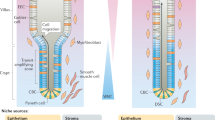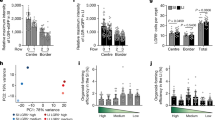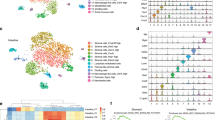Abstract
Homeostasis of self-renewing small intestinal crypts results from neutral competition between Lgr5 stem cells, which are small cycling cells located at crypt bottoms1,2. Lgr5 stem cells are interspersed between terminally differentiated Paneth cells that are known to produce bactericidal products such as lysozyme and cryptdins/defensins3. Single Lgr5-expressing stem cells can be cultured to form long-lived, self-organizing crypt–villus organoids in the absence of non-epithelial niche cells4. Here we find a close physical association of Lgr5 stem cells with Paneth cells in mice, both in vivo and in vitro. CD24+ Paneth cells express EGF, TGF-α, Wnt3 and the Notch ligand Dll4, all essential signals for stem-cell maintenance in culture. Co-culturing of sorted stem cells with Paneth cells markedly improves organoid formation. This Paneth cell requirement can be substituted by a pulse of exogenous Wnt. Genetic removal of Paneth cells in vivo results in the concomitant loss of Lgr5 stem cells. In colon crypts, CD24+ cells residing between Lgr5 stem cells may represent the Paneth cell equivalents. We conclude that Lgr5 stem cells compete for essential niche signals provided by a specialized daughter cell, the Paneth cell.
This is a preview of subscription content, access via your institution
Access options
Subscribe to this journal
Receive 51 print issues and online access
$199.00 per year
only $3.90 per issue
Buy this article
- Purchase on Springer Link
- Instant access to full article PDF
Prices may be subject to local taxes which are calculated during checkout




Similar content being viewed by others
References
Barker, N. et al. Identification of stem cells in small intestine and colon by marker gene Lgr5 . Nature 449, 1003–1007 (2007)
Snippert, H. J. et al. Intestinal crypt homeostasis results from neutral competition between symmetrically dividing Lgr5 stem cells. Cell 143, 134–144 (2010)
Porter, E. M., Bevins, C. L., Ghosh, D. & Ganz, T. The multifaceted Paneth cell. Cell. Mol. Life Sci. 59, 156–170 (2002)
Sato, T. et al. Single Lgr5 stem cells build crypt–villus structures in vitro without a mesenchymal niche. Nature 459, 262–265 (2009)
Garabedian, E. M., Roberts, L. J., McNevin, M. S. & Gordon, J. I. Examining the role of Paneth cells in the small intestine by lineage ablation in transgenic mice. J. Biol. Chem. 272, 23729–23740 (1997)
Van der Flier, L. G. et al. The intestinal Wnt/TCF signature. Gastroenterology 132, 628–632 (2007)
Altmann, G. G. Morphological observations on mucus-secreting nongoblet cells in the deep crypts of the rat ascending colon. Am. J. Anat. 167, 95–117 (1983)
van Es, J. H. et al. Notch/γ-secretase inhibition turns proliferative cells in intestinal crypts and adenomas into goblet cells. Nature 435, 959–963 (2005)
Fre, S. et al. Notch signals control the fate of immature progenitor cells in the intestine. Nature 435, 964–968 (2005)
van Es, J. H., de Geest, N., van de Born, M., Clevers, H. & Hassan, B. A. Intestinal stem cells lacking the Math1 tumour suppressor are refractory to Notch inhibitors. Nature Communication 1, 1–5 (2010)
van der Flier, L. G. et al. Transcription factor achaete scute-like 2 controls intestinal stem cell fate. Cell 136, 903–912 (2009)
Gregorieff, A. et al. Expression pattern of Wnt signaling components in the adult intestine. Gastroenterology 129, 626–638 (2005)
Poulsen, S. S., Nexo, E., Olsen, P. S., Hess, J. & Kirkegaard, P. Immunohistochemical localization of epidermal growth factor in rat and man. Histochemistry 85, 389–394 (1986)
Binnerts, M. E. et al. R-Spondin1 regulates Wnt signaling by inhibiting internalization of LRP6. Proc. Natl Acad. Sci. USA 104, 14700–14705 (2007)
Lustig, B. et al. Negative feedback loop of Wnt signaling through upregulation of conductin/axin2 in colorectal and liver tumors. Mol. Cell. Biol. 22, 1184–1193 (2002)
van de Wetering, M. et al. The β-catenin/TCF-4 complex imposes a crypt progenitor phenotype on colorectal cancer cells. Cell 111, 241–250 (2002)
Moser, A. R., Pitot, H. C. & Dove, W. F. A dominant mutation that predisposes to multiple intestinal neoplasia in the mouse. Science 247, 322–324 (1990)
Chen, B. et al. Small molecule-mediated disruption of Wnt-dependent signaling in tissue regeneration and cancer. Nature Chem. Biol. 5, 100–107 (2009)
Shroyer, N. F., Wallis, D., Venken, K. J., Bellen, H. J. & Zoghbi, H. Y. Gfi1 functions downstream of Math1 to control intestinal secretory cell subtype allocation and differentiation. Genes Dev. 19, 2412–2417 (2005)
Mori-Akiyama, Y. et al. SOX9 is required for the differentiation of paneth cells in the intestinal epithelium. Gastroenterology 133, 539–546 (2007)
Bastide, P. et al. Sox9 regulates cell proliferation and is required for Paneth cell differentiation in the intestinal epithelium. J. Cell Biol. 178, 635–648 (2007)
Bjerknes, M. & Cheng, H. Cell lineage metastability in Gfi1-deficient mouse intestinal epithelium. Dev. Biol. 345, 49–63 (2010)
Ireland, H. et al. Inducible Cre-mediated control of gene expression in the murine gastrointestinal tract: effect of loss of β-catenin. Gastroenterology 126, 1236–1246 (2004)
Ireland, H., Houghton, C., Howard, L. & Winton, D. J. Cellular inheritance of a Cre-activated reporter gene to determine Paneth cell longevity in the murine small intestine. Dev. Dyn. 233, 1332–1336 (2005)
Morrison, S. J. & Spradling, A. C. Stem cells and niches: mechanisms that promote stem cell maintenance throughout life. Cell 132, 598–611 (2008)
Voog, J., D’Alterio, C. & Jones, D. L. Multipotent somatic stem cells contribute to the stem cell niche in the Drosophila testis. Nature 454, 1132–1136 (2008)
Bjerknes, M. & Cheng, H. The stem-cell zone of the small intestinal epithelium. I. Evidence from Paneth cells in the adult mouse. Am. J. Anat. 160, 51–63 (1981)
Bjerknes, M. & Cheng, H. The stem-cell zone of the small intestinal epithelium. III. Evidence from columnar, enteroendocrine, and mucous cells in the adult mouse. Am. J. Anat. 160, 77–91 (1981)
Kim, K. A. et al. R-Spondin proteins: a novel link to β-catenin activation. Cell Cycle 5, 23–26 (2006)
Acknowledgements
We thank H. Begthel, J. Korving and S. van den Brink for technical assistance; J. Gordon for providing small intestinal sections from Cr2-tox177 mice; L. Lum for providing IWP1; and A. Abo for R-spondin 1.
Author information
Authors and Affiliations
Contributions
T.S. and H.C. conceived and designed the experiments. T.S., J.H.v.E., H.J.S., R.G.V., M.v.d.B., N.B. and M.v.d.W. performed the experiments, and T.S., J.H.v.E., H.J.S., D.E.S. and H.C. analysed the data. N.F.S. provided Gfi1−/− mice intestines. T.S. and H.C. wrote the manuscript.
Corresponding author
Ethics declarations
Competing interests
H.C. is an inventor on several patents involving the culture system in this paper, as is T.S.
Supplementary information
Supplementary Figures
The file contains Supplementary Figures 1-6 with legends. (PDF 2696 kb)
Supplementary Movie 1
The movie shows a growing organoid from an Lgr5-EGFP-ires-CreERT2 crypt. The organoid was filmed on a live-imaging confocal microscope for 2.5 days. Note the appearance of GFP-positive Lgr5 stem cells near differential interference contrast-positive Paneth cells at sites of crypt budding. (AVI 5811 kb)
Supplementary Movie 2
The movie shows time course of reassociation of sorted single stem cells and single Paneth cells. 1500 single RFP+ stem cells were recombined with 1500 single YFP+ Paneth cells and filmed over 10 days. Of note, we observed one YFP+ budding structure formation originated from contaminated stem cells in YFP+ Paneth cells. (AVI 24322 kb)
Rights and permissions
About this article
Cite this article
Sato, T., van Es, J., Snippert, H. et al. Paneth cells constitute the niche for Lgr5 stem cells in intestinal crypts. Nature 469, 415–418 (2011). https://doi.org/10.1038/nature09637
Received:
Accepted:
Published:
Issue Date:
DOI: https://doi.org/10.1038/nature09637
This article is cited by
-
Loss of Mptx2 alters bacteria composition and intestinal homeostasis potentially by impairing autophagy
Communications Biology (2024)
-
NAD+ dependent UPRmt activation underlies intestinal aging caused by mitochondrial DNA mutations
Nature Communications (2024)
-
Paneth-like cells produced from OLFM4+ stem cells support OLFM4+ stem cell growth in advanced colorectal cancer
Communications Biology (2024)
-
Intestinal stem cells: guardians of homeostasis in health and aging amid environmental challenges
Experimental & Molecular Medicine (2024)
-
Death receptor 5 is required for intestinal stem cell activity during intestinal epithelial renewal at homoeostasis
Cell Death & Disease (2024)
Comments
By submitting a comment you agree to abide by our Terms and Community Guidelines. If you find something abusive or that does not comply with our terms or guidelines please flag it as inappropriate.



